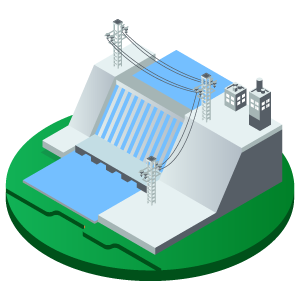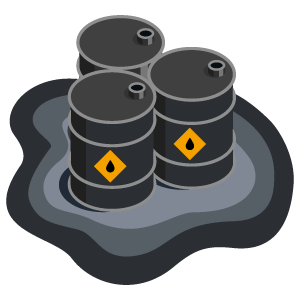Renewable Energy Sources: the definitive guide
The UK has been generating increasing amounts of clean energy from renewable sources since the late 1980s. With gas and oil supplies from the North and Irish seas gradually dwindling and driving wholesale energy prices upwards, Britain needs to commit to green energy to ensure reasonable prices, energy independence and to meet fast approaching emissions targets.
What is renewable energy?
Renewable energy sources are a way of generating power from the natural world sustainably. Also called green energy, there are many types of renewable resources, which are distinct from non-renewable sources of energy in that they do not depend on a finite resource like coal or other fossil fuels.
The way in which renewable energy sources its power can be by using nature to drive turbines or generate heat, or by extracting fuel from organic waste, always without creating carbon emissions. Sustainably capturing or extracting energy from the natural world requires specific tools, technologies and skills tailored to each of these renewable energy sources.
There are many types of renewable energy. They all have a few things in common that distinguish them from fossil fuels and nuclear energy:
- Renewable energy will not run out.
- Renewable energy does not have a negative impact on the environment.
- Renewable energy generation does not cause harmful greenhouse gas emissions.
- Renewable energy does not produce hazardous byproducts that require costly and complex waste management.
What are 5 renewable resources?
In this section, we're going to take you through the five main types of renewable energy.
Solar energy

As you might already be aware, solar energy uses the power of sunlight to generate heat. This heat energy can then be converted into electricity in order to power homes or other buildings.
Solar energy is, without doubt, one of the most popular renewable energy sources worldwide. Solar panels are extremely popular with homeowners living in many different types of homes, both permanent and mobile.
Solar panels are able to either capture heat or transform light from the sun into electricity, depending on their design, and can be effective even outside of warm climates. In order to absorb energy from sunlight, there are a few types of solar panels that can be used:
Solar thermal panels
This technology is generally dedicated to providing hot water to residential households. Essentially, these panels collect sunlight and heat as water circulates through the system, increasing its temperature.
Photovoltaic (PV) solar panels
This is the best-known type of solar technology and for good reason; it can be placed in many different types of homes from terraced homes to caravans and tiny homes. While there are a few PV panel design variants out there, they all do the same thing with varying degrees of efficiency; that is transforming light energy into electricity.
At the same time, solar power technology can be engineered and transformed so it can play a role at the utility scale end of the market, as a commercial energy generation solution.
Solar furnaces
While the above two technologies are focussed on residential energy customers, solar furnaces are able to reach very high temperatures by concentrating solar energy at industrial scales.
By using an array of mirrors to guide sunlight to a single focal point, the energy gathered is sufficient to melt steel, make hydrogen out of methane and even generate electricity by turning water into vapour and driving a turbine.
Wind energy
Wind energy requires the use of turbines, which can be sited either onshore or offshore. They harness the kinetic energy of wind currents to make electricity. As the wind makes the blades of a large propeller turn, that motion is turned into electricity by the mechanical components in the nacelle behind the blades.
Wind energy has the distinction of producing some of the cheapest renewable electricity on the market today, making it pretty popular with green energy suppliers, with MWh costs coming under nuclear and closing in on those of gas.
The UK is a world leader when it comes to wind energy thanks to our infamously windy climate. Onshore and offshore wind energy takes up a large chunk of the UK energy mix when the two are combined. Broadly speaking, it is estimated that wind turbines power over 12 million homes in the UK.
Offshore wind turbines are the true titans of renewable energy both in terms of size and power output. Deepwater wind turbines need foundations that can go as deep as 60m below sea level. Once installed, offshore turbines can tower past 180m in height, almost halfway up the Eiffel tower. Onshore wind turbines are smaller in scale but still follow the same energy generation principles.
Looking at cost-effectiveness, wind energy has managed to beat some fossil fuel-based power stations in terms of cost per MWh making it an extremely attractive proposition for the UK, as the country strives to decarbonise its energy industry.
Hydroelectric energy
Hydroelectric energy is one of the most established and longstanding forms of renewable energy in the UK. There are dozens of dams, reservoirs and run-of-river schemes located around the UK, primarily in Scotland and Wales.

Hydroelectric power, using dams and reservoirs with a pumped-storage option, is a key part of our national electricity infrastructure. These dams and reservoirs are essentially giant emergency batteries that National Grid engineers can call on when there is a peak in demand or a particularly steep shortfall in supply.
These renewable powerhouses can release thousands of litres of water in a matter of seconds driving a turbine, thanks to the force of gravity. Traditional coal, gas and nuclear power stations struggle to meet demand quickly because they can’t change their energy output as quickly as hydroelectric dams can.
A dam with a pumped storage facility will release water from its top reservoir during times of peak demand. This water will be collected in a lower reservoir or lake so that it doesn’t go to waste. When demand is low, that water can then be pumped back up to the higher reservoir so it can be released again whenever the need arises.
Not all hydroelectric plants operate in this way - some dams don’t have the pumped storage ability. This means that the water they release when generating renewable electricity is fed into a river or other existing body of water. In addition, some hydroelectric plants are not dams at all but are installed along large rivers harnessing the natural flow of water. These plants might also be designed to divert water from the river into a parallel conduit that can speed up water velocity or store it before it reaches the hydro turbines. Either way, the water returns to its natural course downriver.
Almost all suitable large-scale hydroelectric sites have already been developed in the UK, with the majority located in the Scottish Highlands. This means that the UK is unlikely to see any new dams being built in the future.
However, this doesn’t mean that the country has maxed out its hydro capacity. There are old water mills all over the country that could be restored and electrified. They could potentially bring in close to an additional 1000 MWh of clean and sustainable electricity.
Tidal Energy
Tidal energy relies, once again, on the moving water to generate electricity. The power and consistency of tides can be effectively utilised to make clean electricity. There are a couple of different approaches to getting power out of tidal currents.
The least intrusive way of tapping into tidal energy is with a network of underwater turbines in locations where there is a significant height difference between incoming and outgoing tides. More often than not, estuaries and bays make great locations for tidal power plants. There are several free-standing underwater turbine designs, ranging from standard propeller designs to underwater kites that trail along with the current and are able to translate that movement into clean electricity.
The other option is to build a tidal barrage that completely blocks off a bay or estuary. This type of low-lying sea wall design has turbines embedded in its base. These are activated by the ebb and flow of the tides. Parts of the tidal barrage can also be opened up to enable the free flow of maritime traffic and additionally, they can provide new transportation links by cutting distances along a bay.
The UK seems to be currently favouring the more scalable freestanding underwater turbine designs which have lower start-up costs, represent a smaller overall risk for financially skittish investors and bring significant logistical flexibility.
Biomass
Anaerobic digestion plants are able to process organic waste or biomass from a variety of sources to extract biogas and fertilising byproducts. Biomass power operates on the composting principle but scales it up to an industrial level.
Biogas itself cannot be directly used to replace the natural gas that flows through the UK gas networks. However, a little extra processing increases methane content, removes impurities, adds an identifiable odour for safety, and with that, biogas can be made into green gas. Biomethane is another name for green gas; it is essentially indistinguishable from natural gas, except for its origin.
Natural gas comes from fossil fuels, meaning that it contributes to global warming and pollution. On the other hand, green gas is a by-product of biomass (organic matter) naturally decaying. This makes green gas significantly more environmentally friendly and sustainable than its fossil fuel counterparts because the decay of natural matter would occur one way or another.
The UK generating capacity for green gas has grown rapidly in recent years. The primary reason is that green gas can be made out of many different kinds of biomass and organic waste slurries and the technology involved here is scalable and fairly cost-effective.
To top it all off, anaerobic digestion plants can produce a range of useful products. First and foremost, we have green gas but that’s not the end of the story. Even unrefined biogas can be used for heating or even powering compatible vehicles or district heat systems and that’s before it even gets processed into green gas.
Other Renewables Energy Sources
There are not only five types of renewable energy to speak of. There are a few other, lesser-known and underused sources which deserve a mention and you may be hearing more of in the years to come.
Geothermal energy
Geothermal energy is an underutilised source of power in the UK. While other countries like Iceland have invested heavily and seen a big pay off from the technology, the UK lags very much behind.
At the industrial end of the scale, geothermal power plants generate electricity by circulating superheated steam from deep inside the earth to drive a turbine that makes electricity above ground. The placement of these plants is highly dependent on geological features, such as hot rocks, to make geothermal power possible.
On the residential side of the market, there is no need to dig down thousands of feet through layers of rock to benefit from geothermal. This is because household geothermal solutions only provide heating and hot water, as opposed to the electricity generated in large quantities.
With this in mind, residential geothermal energy takes the form of ground source heat pumps. What these systems do is extract latent heat from the earth through coils buried 10 to 15 metres underground and piping it back to the house where it’s released through standard heating and hot water systems. Ground source heat pumps end up being more efficient and environmentally friendly than standard boilers.
Hydrogen Energy
Hydrogen energy (link coming soon!) is perhaps the least explored of the renewable energy sources we mention on this page. It involves the generation of electricity through the combination of hydrogen and oxygen atoms. Current technology means that hydrogen fuel cells are disproportionately heavy - a 300kg tank would provide only a few hours of electricity - but the abundance of hydrogen in our atmosphere makes it a promising source of energy looking into the future.

Is Nuclear Energy renewable?
Nuclear energy is often claimed by proponents of the technology to be carbon-neutral, if not entirely renewable. It is true that nuclear energy generation does not involve burning fossil fuels and release carbon emissions in the same way that using coal or natural gas does, but to group it with other renewable energy sources or call it "green" would be a stretch.
Nuclear energy production also results in the production of harmful nuclear waste, which itself has a damaging effect on the environment. This is before getting into the potential for nuclear disasters, the enormous danger this can present and the damage this can do. For more information on nuclear energy, with a balanced discussion on its merits and downsides, see our guide.
Advantages of Renewable Energy
Sustainable energy is a key part in building a better and healthier future for the UK as a whole. Sticking with fossil fuels and nuclear power means more pollution, dwindling resources, depending on foreign energy generators for critical national supply guarantees, no way to bring energy prices under control and making the climate crisis worse for all Britons.
Why sustainable makes sense
Renewable power brings a healthier environment, energy independence and a scalable approach to energy policy that can be both more local and more adaptable to changing needs or new technologies. Let’s take a look at why green energy makes sense.
Solar
- Solar panels are space saving. They can be integrated into many building structures and rooftops throughout the UK.
- Solar energy scales very well: it can be used anywhere from single homes to solar farms on marginal land.
- When coupled with battery storage, solar panels are the best solution for households looking to go off the grid.
- The cost of solar panels is falling rapidly, lowering the barrier to entry significantly.
Wind
- Offshore wind farms can generate large amounts of power.
- Like solar they are scalable, meaning that capacity can be added progressively as government funding or private investment becomes available.
- Wind farms could power pumped storage facilities to balance out uneven energy output, resulting in a natural battery system operating on gravity, teaming up with a secondary renewable system.
Hydroelectric
- Hydroelectric dams are essentially natural battery storage.
- Hydropower is the last line of defense in terms of balancing the power grid. Giving the national grid power when it needs it.
- Dams can start generating power within six seconds of floodgates being opened and releasing water into the turbine.
Tidal
- Tides are extremely predictable unlike some other renewables.
- Free standing tidal turbines can be scaled up like wind turbines, making them adaptable to demand and available funding.
- Since tidal turbines are submerged they avoid many of the NIMBY type complaints about spoiling the view and being noisy.
Biomass
- Biomass energy is a great to alleviate the lack of space in landfills.
- Anaerobic digesters, the power plants that make green gas, can recycle organic waste which cannot be handled by other recycling systems.
- Fertiliser is another useful byproduct generated by this kind of green energy.
Geothermal
- Geothermal is a reliable and dependable source of electricity that can complement other kinds of renewables that may not have the same stability.
- Ground source heat pumps can bring geothermal energy and its benefits to the home in an energy efficient, durable and cost effective way.
- Geothermal power plants can produce heat in addition to electricity which community heating schemes can use to support nearby towns.
How can the UK benefit by going green?
The energy transition to renewables is an ambitious endeavour that requires significant financial and social commitments from all corners of society. Why should British people support green energy?
Renewable energy jobs
Building and maintaining renewable energy systems, big and small, means new jobs and new skills that can be acquired by future generations. This is especially true now as automation and globalisation have significantly impacted the British job market, especially when it comes to industrial sectors.
While some renewable energy technologies are well established, others are very much cutting edge. This means new business opportunities for a country that has lost much of its manufacturing might.
In the retail end of the energy sector, renewable represents new ways of selling energy. Many of the most successful new suppliers challenging the big six are companies, like Tonik and Bulb, offering a greener and more sustainable way of doing business.
Environment
Air pollution is thought to have caused 64,000 UK deaths in 2015 alone. The biggest contributor to air pollution are fossil fuels, whether it’s petrol in cars or natural gas in power plants. Adopting green energy as the only energy source in the UK is the only effective way of mitigating harmful pollutants from entering the air we breathe.
Additionally, fossil fuels are the main driving factor global warming which threatens the extinction of animal and human life on earth. Renewable power sources have been shown to be carbon free, unlike fossil fuels as well as having little impact on the environment throughout their entire lifecycle, from installation to dismantling. The question that remains is: What are we waiting for?